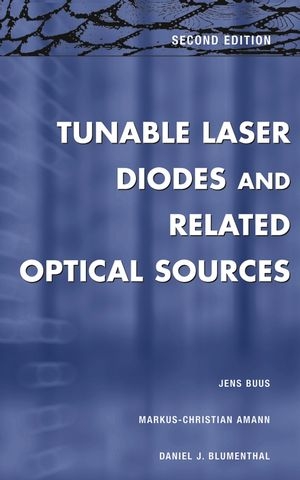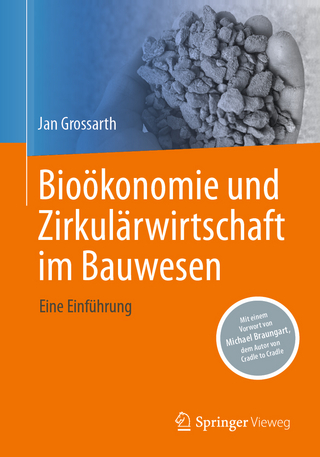
Tunable Laser Diodes and Related Optical Sources
Wiley-IEEE Press (Verlag)
978-0-471-20816-7 (ISBN)
Sources for DWDM Systems is intended for the engineers and graduate students working on optical networks. There is currently a nearly explosive interest in optical networks and the components required for such networks, but there is presently no single work which covers the variety of optical sources which may be used. This book will cover a particular component, tunable lasers, which is the next "big thing" in DWDM.
The primary market are engineers developing tuneable lasers for optical networks, as well as graduate students enrolled in the optical engineering curriculum, especially: optical communication, semiconductor lasers, optical networks, and/or components for optical networks.
JENS BUUS, PhD, is a fellow of the IEEE whose research has made numerous contributions to the understanding of the properties of semiconductor lasers and optical waveguides. He holds five patents and has written two earlier books. A popular speaker, Dr. Buus has presented tutorials and short courses at major conferences, including: ECOC, OFC, EFOC, and the IEEE International Semiconductor Laser Conference. MARKUS-CHRISTIAN AMANN, PhD, is Professor of Electrical Engineering at the Walter Schottky Institute of the Technical University of Munich, Germany. In addition to over 200 publications, conference papers and book chapters, he is a frequent tutorial speaker and short-course presenter on semiconductor lasers, and has served on numerous conference committees such as CLEO, IEEE Semiconductor Laser Conference, IEEE LEOS annual meeting, ECIO and APOC. His present research areas are wavelength-tunable laser diodes, long-wavelength surface-emitting lasers, and microwave semiconductors. DANIEL J. BLUMENTHAL, PhD, is Professor of Electrical Engineering at the University of California at Santa Barbara. In addition to being a Fellow of the IEEE/LEOS and member of the OSA, Professor Blumenthal is also an associate editor for IEEE Photonics Technology Letters and has served as associate and guest editor for several other IEEE publications. Along with publishing several hundred journal articles, conference presentations, magazine articles, and book chapters, he has served as chairman or on the organizing committees of numerous conferences, including OFC, ECOC, OSA Topical Meeting on Photonics in Switching and CLEO. Professor Blumenthal's current research areas include optical wavelength conversion and regeneration, optical packet switching and photonic integration.
Foreword. Preface.
1 Introduction.
2 Fundamental Laser Diode Characteristics.
2.1 Optical Gain in Semiconductors.
2.2 Semiconductor Heterostructures.
2.2.1 Carrier Confinement.
2.2.2 Optical Confinement.
2.2.3 Material Systems.
2.3 Waveguiding and Transverse Laser Modes.
2.3.1 The Slab Waveguide.
2.3.2 Lateral Waveguiding.
2.4 Laser Structures.
2.5 The Fabry–Perot Laser.
2.6 The Rate Equations.
2.6.1 Stationary Solution of the Rate Equations.
2.6.2 Laser Spectrum and Side-Mode Suppression.
2.6.3 Small-Signal Modulation Behavior.
2.7 Quantum Well Laser Diodes.
3 Single-Mode Laser Diodes.
3.1 Mode Selectivity Requirements.
3.2 Wave Propagation in Periodic Structures.
3.2.1 Alternative Derivation of the Coupled-Mode Equations.
3.2.2 Solution of the Coupled-Mode Equations.
3.3 Distributed Bragg-Reflector Lasers.
3.3.1 Magnitude and Phase of Reflection.
3.3.2 Grating Shapes.
3.3.3 DBR Laser Structures.
3.4 Distributed-Feedback Lasers.
3.4.1 DFB Laser With Nonreflecting Facets.
3.4.2 DFB Lasers With Reflecting Facets.
3.4.3 Phase-Shifted and Gain-Coupled DFB Lasers.
3.5 Laser Fabrication and Tolerances.
3.5.1 Wavelength Dependence on Structural Parameters.
3.5.2 Thermal Properties under CW Operation.
3.6 Spectral Linewidth.
4 Basic Concepts of Tunable Laser Diodes.
4.1 Continuous, Discontinuous, and Quasicontinuous Tuning Schemes.
4.2 Tuning of Cavity Gain Characteristic.
4.3 Tuning of Comb-Mode Spectrum.
4.4 Simultaneous Tuning of Cavity Gain and Comb-Mode Spectrum.
4.5 Electronic Wavelength Control.
4.5.1 The Free-Carrier Plasma Effect.
4.5.2 The Quantum-Confined Stark Effect.
4.5.3 Thermal Tuning.
4.6 Integration Techniques.
4.7 Dynamic Behavior.
5 Wavelength-Tunable Single-Mode Laser Diodes.
5.1 Longitudinally Integrated Structures.
5.1.1 Two-Section DBR Laser.
5.1.2 Three-Section DBR Laser.
5.1.3 Multisection DFB Laser.
5.2 Transversely Integrated Structures.
5.2.1 Tunable Twin-Guide DFB Laser.
5.2.2 Striped Heater DFB Laser.
5.3 Integration Technology.
5.4 Physical Limitations on the Continuous Tuning Range.
5.5 Tuning Dynamics and Modulation.
6 Linewidth Broadening.
6.1 Injection–Recombination Shot Noise in the Tuning Region.
6.2 Impedance and Thermal Noise of Bias Source.
6.3 Spatial Correlation.
6.4 1/f Noise.
6.5 Fluctuations of Bias Source.
7 Widely Tunable Monolithic Laser Diodes.
7.1 The Vernier Effect.
7.2 DBR-type Laser Structures.
7.2.1 Sampled-Grating DBR Lasers.
7.2.2 Superstructure-Grating DBR Lasers.
7.2.3 Digital Supermode DBR Lasers.
7.2.4 Superimposed and Binary Gratings.
7.3 Interferometric Structures.
7.3.1 Lateral Integration: The Y-Laser.
7.3.2 Transverse Integration: The VMZ Laser.
7.4 Codirectionally Coupled Laser Diodes.
7.4.1 Theory for Codirectional Coupling.
7.4.2 Tuning and Mode Spacing.
7.4.3 Longitudinally Integrated Structures.
7.4.4 Transversely Integrated Structures.
7.5 Combination of Techniques.
7.5.1 The Grating-Coupled Sampled-Reflector Laser.
7.5.2 The Modulated-Grating Y-structure Laser.
7.6 Comparison of Widely Tunable Monolithic Laser Structures.
8 Practical Issues Related to Monolithic Tunable Laser Diodes.
8.1 Characterization and Control.
8.1.1 DFB and DBR Lasers.
8.1.2 Widely Tunable Lasers.
8.2 Wavelength Stability and Aging.
8.3 Modulation and Wavelength-Switching Dynamics.
8.3.1 Modulation and Transmission.
8.3.2 Wavelength Switching.
8.4 Monolithic Integration.
9 Related DWDM Sources.
9.1 External-Cavity Lasers.
9.1.1 External Grating and External Filter Cavities.
9.1.2 MEMS External Cavities.
9.1.3 Hybrid Structures.
9.2 Vertical-Cavity Lasers.
9.2.1 VCSEL Basics.
9.2.2 Tunable VCSELs.
9.3 Laser Arrays.
9.3.1 Multistripe Arrays.
9.3.2 Selectable Arrays.
9.3.3 DBR Arrays.
9.3.4 Phased Arrays.
9.4 Technology Summary.
9.5 Fiber and Waveguide Lasers.
9.6 Tunable Pulse Sources and Comb Generators.
10 Communications Applications and Requirements.
10.1 Wavelength Tunability.
10.1.1 Tuning Speed and Latency.
10.1.2 Tuning Continuity.
10.1.3 Tuning Uniformity.
10.1.4 Tuning Stability and Accuracy.
10.1.5 Other Design Considerations.
10.2 Functions and Components.
10.2.1 Tunable Transmitters and Transponders.
10.2.2 Tunable Wavelength Converters with Regeneration Capability.
10.2.3 Optical Wavelength Switches.
10.3 Communications Applications.
10.3.1 Point-to-Point Links and Networks.
10.3.2 Fixed-Wavelength Networks.
10.3.3 Reconfigurable Networks.
10.3.4 Optical-Protection Switching.
10.3.5 Optical-Burst Switching.
10.3.6 Photonic-Packet Switching.
11 Other Applications.
11.1 Optical Frequency-Modulated Continuous-Wave Radar.
11.2 Optical Components Characterization.
11.3 Trace-Gas Sensing, Environmental Analysis, and Spectroscopy.
11.4 Heterodyne Techniques.
11.5 Optical Spectrum and Network Analysis.
11.6 Anemometry.
Appendix A: Refractive Index of InGaAsP.
Appendix B: The Slab Waveguide.
Appendix C: Transfer Matrices.
Appendix D: Thermal Response of a Laser Diode.
D.1 Pulse Response in the Time Domain.
D.2 Response in the Frequency Domain.
Appendix E: Theory for General Reflectors.
Appendix F: Codirectional Coupling.
List of Symbols.
List of Acronyms.
Index.
About the Authors.
| Erscheint lt. Verlag | 4.3.2005 |
|---|---|
| Zusatzinfo | Drawings: 165 B&W, 0 Color |
| Sprache | englisch |
| Maße | 158 x 241 mm |
| Gewicht | 699 g |
| Themenwelt | Naturwissenschaften ► Biologie ► Ökologie / Naturschutz |
| Technik ► Elektrotechnik / Energietechnik | |
| Technik ► Umwelttechnik / Biotechnologie | |
| ISBN-10 | 0-471-20816-7 / 0471208167 |
| ISBN-13 | 978-0-471-20816-7 / 9780471208167 |
| Zustand | Neuware |
| Haben Sie eine Frage zum Produkt? |
aus dem Bereich


